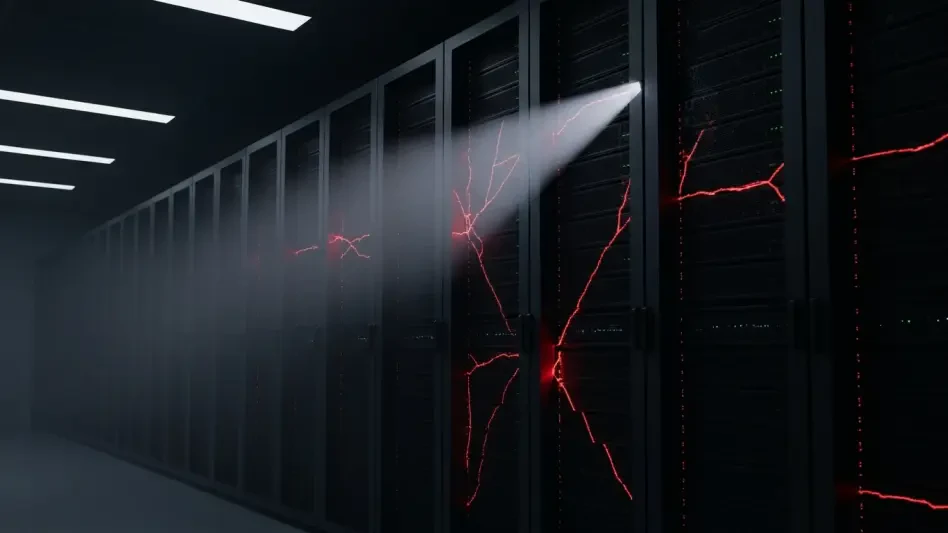The escalating threat landscape surrounding industrial systems has reached a critical point in 2025, driven by increased ransomware attacks targeting operational technology systems within key industries. These cyberattacks pose significant risks to infrastructure, affecting sectors essential to societal function such as manufacturing, energy, and water treatment. Comprehensively detailed in Honeywell’s latest Cyber Threat Report, the severity and sophistication of the attacks underscore the urgent necessity for fortified cybersecurity measures. Understanding the nature of these threats, the actors involved, and the implications for industrial operations is crucial for shaping a resilient defensive strategy in response to these mounting cyber risks.
Rise of Sophisticated Ransomware Attacks
Cl0p Group and W32.Worm.Ramnit Trojan Intensification
The report reveals a striking 46 percent surge in ransomware attacks targeting industrial operators, marked by aggressive campaigns from notable threat actors like the Cl0p ransomware group. The resurgence of the W32.Worm.Ramnit Trojan, with its activity skyrocketing by 3,000 percent, highlights how cybercriminals have adapted their strategies to exploit vulnerabilities within OT systems. The Cl0p group has been particularly adept at leveraging these vulnerabilities, repurposing traditional malware to gain unauthorized access to critical industrial systems. This trend demonstrates the evolving techniques cybercriminals employ, focusing on OT credentials as vulnerable entry points to secure control over industrial operations.
The report’s findings highlight the critical role that ransomware plays in this evolving threat landscape, with industrial entities experiencing significant disruptions in recent months. These attacks often lead to unplanned downtimes and operational bottlenecks, exerting substantial pressure on supply chains. While no new strains have been identified as specifically targeting industrial control systems, the persistent threat of existing malware such as W32.Worm.Ramnit underscores the potential impact of these attacks. As the threat landscape evolves, understanding these dynamics is key to mitigating risks and fortifying industrial infrastructure against these intrusions.
USB Devices as Persistent Threat Vectors
Another key finding of the Honeywell report is the role of USB devices as persistent and often overlooked conduits for cyber threats. The report points out that USB-based threats account for one in four top security incidents. Despite being a traditional threat vector, USB devices remain a considerable source of vulnerability within industrial settings. This reveals a glaring need for stringent monitoring and control over device connections, particularly given their ability to bypass network defenses and directly target sensitive systems. The introduction of malware via USB devices can lead to significant disruptions and data breaches, making it a critical weak link in the cybersecurity armor of industrial entities.
In response to these vulnerabilities, industrial system operators are urged to implement robust controls and monitoring mechanisms for all device connections within their environments. Fortifying these potential entry points requires a multi-layered approach, incorporating strict controls over device management, regular auditing of device interactions, and implementing protocols to ensure that any unauthorized access is swiftly detected and countered. By addressing the vulnerabilities highlighted by the persistent USB threat vector, operators can significantly reduce their risk exposure and enhance their defenses against intrusion.
Sector-Specific Cyber Threats
Impact on Manufacturing and Energy Sectors
The report accentuates the considerable disruptions caused by ransomware on industries like manufacturing and energy, which, as critical infrastructures, remain prime targets for cybercriminals. The impact on manufacturing hubs is extensive, often causing operational delays and workforce idleness due to unforeseen downtimes. Such interruptions not only affect immediate production schedules but also ripple through the supply chains, causing widespread operational inefficiencies. For energy suppliers, the consequences loom larger, potentially jeopardizing national grids and power distribution networks at a time when the reliance on these systems is increasing globally.
The prolonged nature of these disruptions is emphasized by existing malware strains that exploit systemic inadequacies within industrial control systems. The cascading effect of these cyberattacks highlights the necessity for tighter security protocols across multiple touchpoints within industrial operations. Fast-tracking improvements in cybersecurity infrastructure within these sectors is essential to withstand the scale and frequency of cyberattacks. Strengthening in-house capabilities, streamlining incident response frameworks, and fostering collaboration across public and private entities form the backbone of a formidable offensive against these growing cyber threats.
Agricultural and Food Production Vulnerabilities
Reflecting a concerning trend, the agricultural and food production industries have emerged as new targets for cyberattacks, illustrating an evolving threat landscape. Historically, these sectors have been bypassed in cybercriminal agendas, leaving them vulnerable due to their lack of rigorous cybersecurity infrastructure. However, as cyber adversaries adopt more sophisticated and wide-reaching modus operandi, these sectors have now become exposed entry points for broader systemic disruptions. The report highlights successful cyber infiltrations into these sectors as a wake-up call for industry stakeholders.
Securing agricultural and food production sectors against cyberattacks is an urgent priority, given their critical role in ensuring food security and public health. Implementing comprehensive security measures tailored to the unique operational requirements of these sectors is paramount. By employing targeted risk assessments, investing in modern cybersecurity solutions, and fostering collaborations with cybersecurity experts, the agricultural industry can minimize vulnerabilities and bolster its defenses. The goal is to create a resilient framework that can withstand the evolving strategies employed by cybercriminals and protect essential supply chains from disruption.
Public Service Infrastructure Under Siege
Water Utilities and Transportation Networks
The Honeywell report brings attention to the alarming vulnerabilities of public service infrastructures, particularly emphasizing the grave risks associated with potable water systems. The U.S. Environmental Protection Agency has highlighted potential breaches that pose threats to public safety, with concerns magnified following a notable breach in 2024 impacting major water utilities across several states. Such vulnerabilities underscore the urgent need for enhancing cybersecurity measures within these critical systems to protect public health and maintain societal well-being.
Similarly, public transportation networks globally are witnessing an upsurge in cyber threats, exemplified by recent incidents, such as the attack on a Japanese airline. These assaults highlight the pervasive nature of cyber risks, as they threaten not just operational integrity but also public confidence. The Transportation Security Administration’s proposed rules mandating stricter cybersecurity protocols for railroads and pipelines underscore the critical need for fortified defenses. Collective global efforts, bolstered by stringent regulatory frameworks and international cooperation, are necessary to counter these incursions effectively.
Strengthening Cybersecurity Defenses
In light of these vulnerabilities, the adoption of comprehensive cybersecurity frameworks, such as Zero Trust models, is increasingly emphasized as a strategic response to bolster defenses. Implementing these models involves restricting access to only verified and necessary operations, employing AI-driven analytics, and using continuous monitoring to enhance threat detection capabilities. Embracing these advanced strategies is crucial for elevating cybersecurity postures, ensuring resilient protection against both current and emerging threats.
A more robust security framework also involves prioritizing multi-factor authentication, enhancing password policies, and investing in network segmentation. These measures, alongside data encryption and maintaining securely audited backups, are advocated as foundational practices for safeguarding critical assets. Continuous vulnerability assessments, adherence to established standards like NIST 800-82 and IEC 62443, and cultivating a culture of cybersecurity awareness become central to minimizing risk and achieving a fortified, risk-mitigated environment in increasingly volatile cyberspaces.
Proactive Measures for Industrial Security
Embracing Cutting-Edge Security Technologies
In response to the incriminating findings, Honeywell underscores the imperative for industrial entities to engage actively with state-of-the-art security technologies. A proactive approach to cybersecurity involves regular training programs for employees aimed at heightening awareness of cyber threats and equipping staff with the skills to mitigate these risks effectively. Effective identity management systems are pivotal in detecting and preventing unauthorized access, while regular software updates and patches ensure protection against newly identified vulnerabilities, reducing risks of exploitation by threat actors.
Moreover, organizations are encouraged to adopt advanced security solutions like cloud-native security tools that offer scalable and efficient protection. Visualizing network communications becomes crucial in detecting anomalies, prompting timely responses to unauthorized operations. By integrating these technologies, industrial operators can significantly enhance their cybersecurity posture, lending to a resilient framework capable of adapting to the fluid landscape of cyber threats. This strategic adoption of new technologies is essential for staying ahead in the relentless battle against cyber incursions.
Fostering a Resilient Cybersecurity Culture
By 2025, the threat landscape surrounding industrial systems has become increasingly perilous, largely due to a surge in ransomware attacks specifically targeting operational technology systems in vital industries. These cyberattacks represent a significant danger to critical infrastructure, impacting essential sectors such as manufacturing, energy, and water treatment—industries crucial to the proper functioning of society. In Honeywell’s recently published Cyber Threat Report, the escalating gravity and sophistication of these attacks are systematically documented, highlighting the urgent necessity for enhanced cybersecurity measures. Understanding the nature of these threats, identifying the actors responsible, and evaluating the implications for industrial operations are essential steps in developing a strong and resilient defense strategy. As cyber threats continue to evolve, adapting our security measures to safeguard essential industrial systems becomes increasingly critical to protect society’s backbone against these ever-expanding digital risks.








